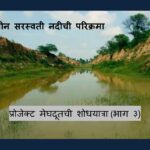Center for Citizen Science (CCS) has initiated many research projects involving students, citizens and scientists. After developing the concept of research project, students and citizens conduct field work for scientific data collection, sample collection and observations, they also work in research labs for the analysis and scientists support them with infrastructure and guidance.
Here are some completed research projects by Team CCS
- Microbial analysis of river Ganga:
 Study of changes in microbial diversity across path of Ganga from Gomukh to Gangasagar. Survey and sample collection was carried out by CCS members during July 2015 and Laboratory analysis was done by National Centre for Microbial Resource (NCMR). Research paper has been published in Current Microbiology journal in September 2017 issue.
Study of changes in microbial diversity across path of Ganga from Gomukh to Gangasagar. Survey and sample collection was carried out by CCS members during July 2015 and Laboratory analysis was done by National Centre for Microbial Resource (NCMR). Research paper has been published in Current Microbiology journal in September 2017 issue. - SATARK Landslide Prediction System:
 Western Ghats is one of the vulnerable region for landslides during Monsoon. In recent years there are many casualties have been reported due to the landslides during heavy rainfall spells. CCS has done systematic study of landslide events in Maharashtra in last decades and related rainfall events. We found the threshold values of heavy rainfall which indicates the higher possibility of landslides in the particular region. CCS also created the first landslide prone map of northern western ghats for monitoring higher rainfall events to predict landslides at least one day ahead. Research was presented through poster in National Space Science Symposium arranged by ISRO in Vikram Sarabhai Space Centre (VSSC) in February 2016.
Western Ghats is one of the vulnerable region for landslides during Monsoon. In recent years there are many casualties have been reported due to the landslides during heavy rainfall spells. CCS has done systematic study of landslide events in Maharashtra in last decades and related rainfall events. We found the threshold values of heavy rainfall which indicates the higher possibility of landslides in the particular region. CCS also created the first landslide prone map of northern western ghats for monitoring higher rainfall events to predict landslides at least one day ahead. Research was presented through poster in National Space Science Symposium arranged by ISRO in Vikram Sarabhai Space Centre (VSSC) in February 2016. - Microbial analysis of ‘Dust Storm’ event:
 Unusual dust storm was reported in Western Maharashtra in the first week of April 2015. Joint team of CCS- NCCS carried out a rapid air survey from Pune to Maumbai to find out microbes from the unusual weather event. The team carried out another survey from same locations one month after the event to study neutral conditions. Results of the study are now ready and soon will be published in scientific journal.
Unusual dust storm was reported in Western Maharashtra in the first week of April 2015. Joint team of CCS- NCCS carried out a rapid air survey from Pune to Maumbai to find out microbes from the unusual weather event. The team carried out another survey from same locations one month after the event to study neutral conditions. Results of the study are now ready and soon will be published in scientific journal. - Asteroid occultation observation:
 Asteroid 22 Kalliope occulted a 9 magnitude star TYC-2430-01124-1 on 25 December 2016 and was clearly observed from India from the multiple locations in Maharshtra on the predicted path. Three teams from CCS could observe the occultation through telescope successfully and one team by photographic method. Occultation duration were recorded different at different locations across the predicted path. The star was occulted briefly for 8.5 seconds by the asteroid near the central path. The results were submitted to International Occultation Timing Association (IOTA), three of the CCS readings were considered by IOTA to predict the shape of the asteroid.
Asteroid 22 Kalliope occulted a 9 magnitude star TYC-2430-01124-1 on 25 December 2016 and was clearly observed from India from the multiple locations in Maharshtra on the predicted path. Three teams from CCS could observe the occultation through telescope successfully and one team by photographic method. Occultation duration were recorded different at different locations across the predicted path. The star was occulted briefly for 8.5 seconds by the asteroid near the central path. The results were submitted to International Occultation Timing Association (IOTA), three of the CCS readings were considered by IOTA to predict the shape of the asteroid.




